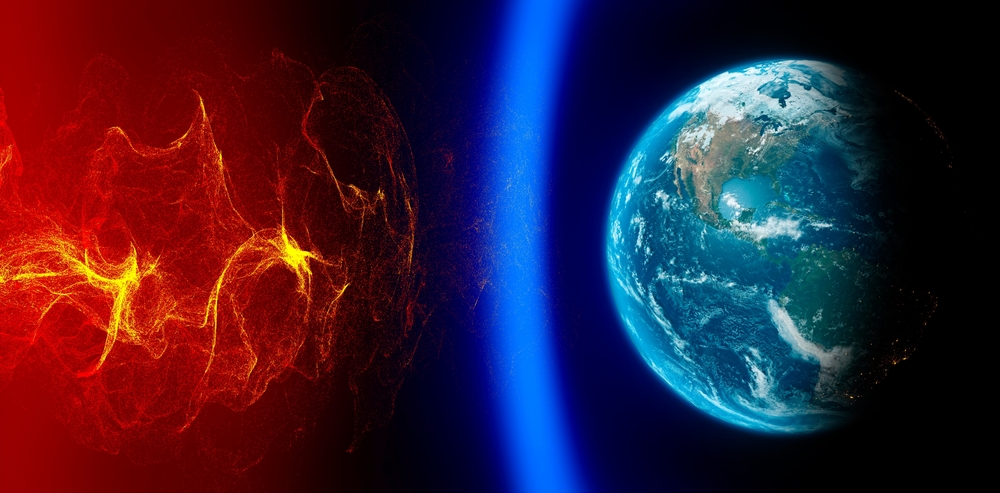
How Does Earths Magnetic Field Work?
www.discovermagazine.com
One of the many unseen forces to which you owe your existence is magnetism. If it werent for the magnetic field that surrounds our planet, blocking cosmic radiation and solar wind, Earth would likely have little atmosphere to speak of. Life (at least of the human variety) would be impossible.Changes in the field can also play havoc with satellite communication and electric infrastructure, disrupting the modern world in a big way. Given the importance of this gargantuan bar magnet in our day-to-day lives, its worth understanding how it works and when it doesnt.Where Earths Magnetic Field Comes FromSince the magnetic field is sustained by geological activity deep within our planet, lets start with an overview of its structure. Although weve hardly scratched Earths surface (the center lies nearly 4,000 miles deep, and the deepest borehole penetrated just 7.6 miles), scientists can study the interior with some help from earthquakes: As seismic waves ripple through, changes in their speed and direction provide loads of data on the likely makeup of the different layers. The rocky crust extends 5 miles to 40 miles beneath the surface, depending on your location. Beneath that is 1,800 miles of mostly solid mantle, then another 1,400 miles of molten outer core, and finally, a dense sphere forms the solid inner core. What matters for our purposes is the outer core. Its composed predominantly of iron and nickel which are, importantly, in fluid form. As heat from the red-hot inner core radiates outward, it drives turbulent convection currents in the outer core. All that molten metal conducts electricity, so as it moves it creates an electric current, which in turn generates a magnetic field. As you may recall from Physics 101, a changing magnetic field (like when you slide a bar magnet through a copper coil) induces an electric current. At planetary scale, Earths magnetic field induces such a current, which regenerates the magnetic field, which induces more current, and so on in a self-sustaining process known as a geodynamo.German physicist Walter Elsasser first proposed this mechanism and it is now widely accepted. One day he took the idea to his friend Albert Einstein, a famous stickler for tidy scientific explanations. When Elsasser had summed up the (admittedly messy) hypothesis, Einstein reportedly told him it was too complicated to be impossible. For once, wrote the German historian F. Krause, the great mans craving for simplicity seems to have misled him.Why do Earths Magnetic Poles Reverse? Today the magnetic field is more or less aligned with Earths rotational axis (each pole lies about 11 degrees off from the geographic poles). But it isnt fixed in place the complex motions of the geodynamo cause the magnetic poles to wander, and every so often Earths polarity fully reverses magnetic north and magnetic south swap positions. (Geographic north and south, of course, remain unchanged)These reversals are apparently random. They might happen every 10,000 years, or not for millions. The last one was 780,000 years ago. We only know about them because some volcanic rocks had aligned themselves with Earths magnetism, preserving the signature of the field at the time they cooled. Thus, if we can date the rocks, we can tell north from south in that era.Reversals dont happen instantly, but over a period of thousands of years as the magnetic field gradually weakens. Though its strength has decreased by about 10 percent at Earths surface since scientists began monitoring it in the 1830s, theres no reason to think a reversal is imminent; paleomagnetic records show that the intensity drops by up to 90 percent in the process of pole-switching.How the Magnetic Field Protects UsWe should all feel grateful that we live in a time of magnetic stability, because the field acts as a protective bubble, interacting with harmful particles just beyond the outermost layer of Earths atmosphere. It deflects the cosmic rays that constantly whiz through space from our sun and other stars. That said, it isnt a perfect shield. Sometimes the sun emits large bursts of magnetized solar plasma, called coronal mass ejections, which can cause major disturbances in the magnetosphere. These geomagnetic storms may interfere with GPS systems and damage large conducting systems like power grids and pipelines. At the same time, they also produce beautiful auroras, like the one that dazzled North America in May of 2024.Article SourcesOur writers at Discovermagazine.com use peer-reviewed studies and high-quality sources for our articles, and our editors review for scientific accuracy and editorial standards. Review the sources used below for this article:Britannica. Electric generatorThe cosmic dynamo: proceedings of the 157th Symposium of the International Astronomical Union held in Potsdam. The Cosmic Dynamo: From t= -infinity to Cowling's Theorem. A Review on HistoryNOAA. Coronal Mass EjectionsNOAA. Geomagnetic StormsCody Cottier is a contributing writer at Discover who loves exploring big questions about the universe and our home planet, the nature of consciousness, the ethical implications of science and more. He holds a bachelor's degree in journalism and media production from Washington State University.
0 Commenti
·0 condivisioni
·99 Views


